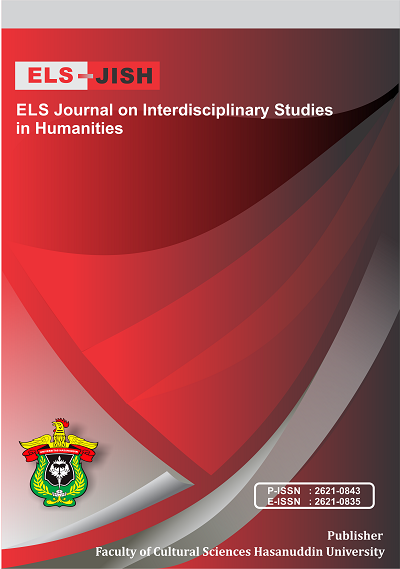Escapism in Eugene O’Neill’s Long day's Journey into Night
DOI:
https://doi.org/10.34050/elsjish.v7i1.33077Keywords:
Alcoholism, Escapism, Drug addiction, Past, TyronesAbstract
Long day's Journey into Night (Pulitzer Prize 1957) was Eugene O’Neill’s greatest autobiographical play in which he skillfully conveys through the members of his family a painful realistic portrait that reveals the strained familial relationships he experienced with his family during his youth. The play represents a day in the life of the Tyrones, which begins at 8:30 in the morning on James Tyrone's (the father) farm in August 1912 and ends in the last hours of the same day. It is a metaphorical, psychological, gradual, desperate journey that all the Tyrones take into the night (towards their personal problems) to explore the uttermost depth of familial relationship through their mutual accusations and blaming each other until they are separated by the darkness of their problems which isolate them from each other urging them to escape from their miserable and tragic reality by taking drugs, drinking and prostitutes. Escapism is one of the main themes of the play that is seen and justified by the depression, hostility and tension experienced by the four characters of the Tyrones family. They are unable to face their life's problems and they only get blame and mutual accusations from each other without the expected family attention and sympathy among them. The paper is an attempt to investigate the different motivations of the Tyrones for escaping from their bitter reality and the means used to do so.
References
Abbotson, S. C. W. (2005). Masterpiece of 20th century American Drama. London, Greenwood press ,1968: p.107.
Alaaldin, S. S., & Abdulsalam, H. B. (2021). Alcoholism and Identity Change in Eugene O’Neill’s Long Day's Journey into Night. Koya University Journal of Humanities and Social Sciences, 4(1), 45-52.
Begum, T. (2020). Fog as a Symbol of Alienation in Both Physical and Psychological World in O’Neill’s Long Day’s Journey into Night. International Journal of Linguistics, Literature and Translation (IJLLT).
Cargill, O., Fagin, N. B., & Fisher, W. J. (1961). O’Neill and His Plays: Four Decades Criticism. New york: University press, 1961: p.218.
Carpenter, F. I. (1964). Eugene O’Neil. New York: Harper& Row Publishers, Inc., 1964) p.160
Chabrow, L. (1978). Ritual and Pathos. The Theater of Engine O’Neill Cloveburg. Bucknell University Press, p. 76.
Chabrowe, L. (1976 ). Ritual and Pathos The Theatre of O'Neill. Lewisburg: Bucknell University Press, p. 173.
Champan, J. (1964). Long Day's Journey Into Night, Playwright's Progress! ONeill and the Critics Ed. Jordan Miller Chicago, p.134.
Faiz, T. F. T., Colonel, C. R. A. K. D., & Khalili, A. (2023). An Analysis of Eugene O’Neil’s Play “Long Day’s Journey into Night” with Reference to Sigmund Freud’s Theory of Defense Mechanism. Perodicals of Social Sciences, 3(1), 254-272.
Gannon, P. W. (1965). Eugene O'Neill's Long day's Journey Into Night: A Critical Commentary. New York: Monarch Press, p. 66.
Gassner, J. (1969). ed O'Neil: A Collection of Critical Essays, Johattenry Raliegh. New Jersey Princeton-Halt.
Gassner, J. (1965). Eugene O’Neill. Minneapolis. University of Minnesota Press, 19657840 Gassner.
O'Neill, E. (1970). Long Day's Journey Into Night. New Haven1 Yale University Press.
Rahman, F. (2018). The constraints of foreign learners in reading English literary works: A case study at Hasanuddin University. Journal of Arts and Humanities, 7(2), 01-12.
Raliegh, J. H. (1969). O’Neill’s Long day's Journey Into Night and New. England Irish Catholicism, in O’Neill: A Collection of Critical Essays, Ed. John Gassner, New Jersey Princeton Hall, Inc.
Raliegh, J. H. (1966). The Plays of Eugene O’Neill. Hin Carbonda Southern Illinois University Press, p. 1442.
Suma, M., Rahman, F., Dalyan, M., Rahman, F. F., & Andini, C. (2023). Literature And Family Development: A Character Building Education. Journal of Namibian Studies: History Politics Culture, 39, 220-232.
Tilak, R. (1981). Eugene O’Neill’s Desire Under the Elms: A Critical Study New Delhi. Rama Brothers Educational Publishers, p.19.
Tiusanen ,T. (1968). O’Neill’s Scenic Image. Jersey: Princeton university press, p.288.
Downloads
Published
Issue
Section
License
Copyright (c) 2024 Safaa Haqi Ismaiel, Zeena Salim Hammoudi, Susan Raheem Rahman Jaf

This work is licensed under a Creative Commons Attribution-ShareAlike 4.0 International License.






